
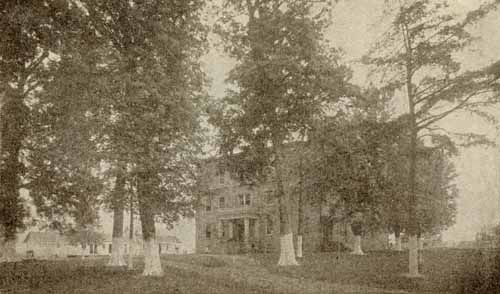
In 1902, G. F. Richings wrote a book titled, Evidences of Progress Among Colored People in which he described many of the African-American schools then in existence. Included was a piece on Eckstein Norton University which was located at Cane Springs in Bullitt County.
This work has been transcribed from the original which is located on microfiche and available in the Captain John Smith Library of Christopher Newport University in Newport News, Virginia. It is also available online via Google Books where it is scanned from the copy available at Stanford University.
Additionally, below this article is a transcription of a 1902 Courier-Journal article about the school. Click this link to jump to that article.
Evidences of Progress Among Colored People
G. F. Richings
Tenth Edition, 575 p., illus.
Philadelphia: G. S. Ferguson Co., 1903
Copyright 1902 by G. F. Richings
CHAPTER XII.
pages 218-230
THIS school was founded by one of the most successful educators of the race, the late Rev. Wm. J. Simmons, D. D., and his associate, Rev. C. H. Parrish, A. M., who is its worthy president. In 1890 it opened under the most favorable auspices, and each year has succeeded beyond the sanguine expectations of its friends. For purity of atmosphere, for development of the physical powers, for freedom from the allurements and unwholesome amusements of city life, no better place could have been selected than Cane Spring, Bullitt county, Ky., twenty-nine miles from Louisville.
The object is to teach the students how to work; to teach the dignity of labor, that hands must be used as well as heads and that both can be successfully used together. It teaches manliness and race pride; that skill tells regardless of skin or parentage. It gives, besides the industries, a literary training which begins with the primary and ends with the college. As much is required from the study of the Bible as from any other book.
This school has had its adversities in deaths of teachers and conflagration of buildings, yet it has bravely struggled through all.
Its session for 1896 opened with students from fourteen different States, and with prospects bright and encouraging. Students who enter this University must come with a purpose and must use with profit their time. Anything short of this will not be tolerated.
Children who come as young as eight years are under a special matron who cares for them as a mother. In the Industrial Department will be found carpentry, blacksmithing, farming, printing, plain-sewing, dressmaking, tailoring, cooking, etc. Business Department includes Shorthand, Typewriting, Bookkeeping, etc.
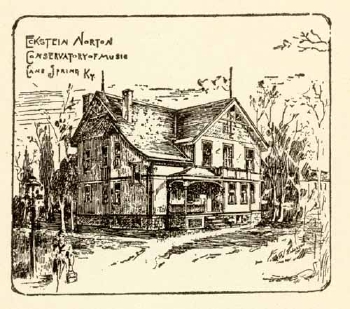
The Musical Conservatory is the first of the race manned by teachers from the best Conservatories of Music of this country. The course of study is in accord with Oberlin, Boston, Chicago and others. A Conservatory building is now being erected under the direction of Prof. Hattie A. Gibbs, who has traveled extensively through the East in its interest.
The picture below is said to be of members of the University Band. It is provided to us by Pastor David McPherson who is seeking to identify the people in the picture. If you have information about this group or the names of any of the individuals, please use our contact page to correspond with us.
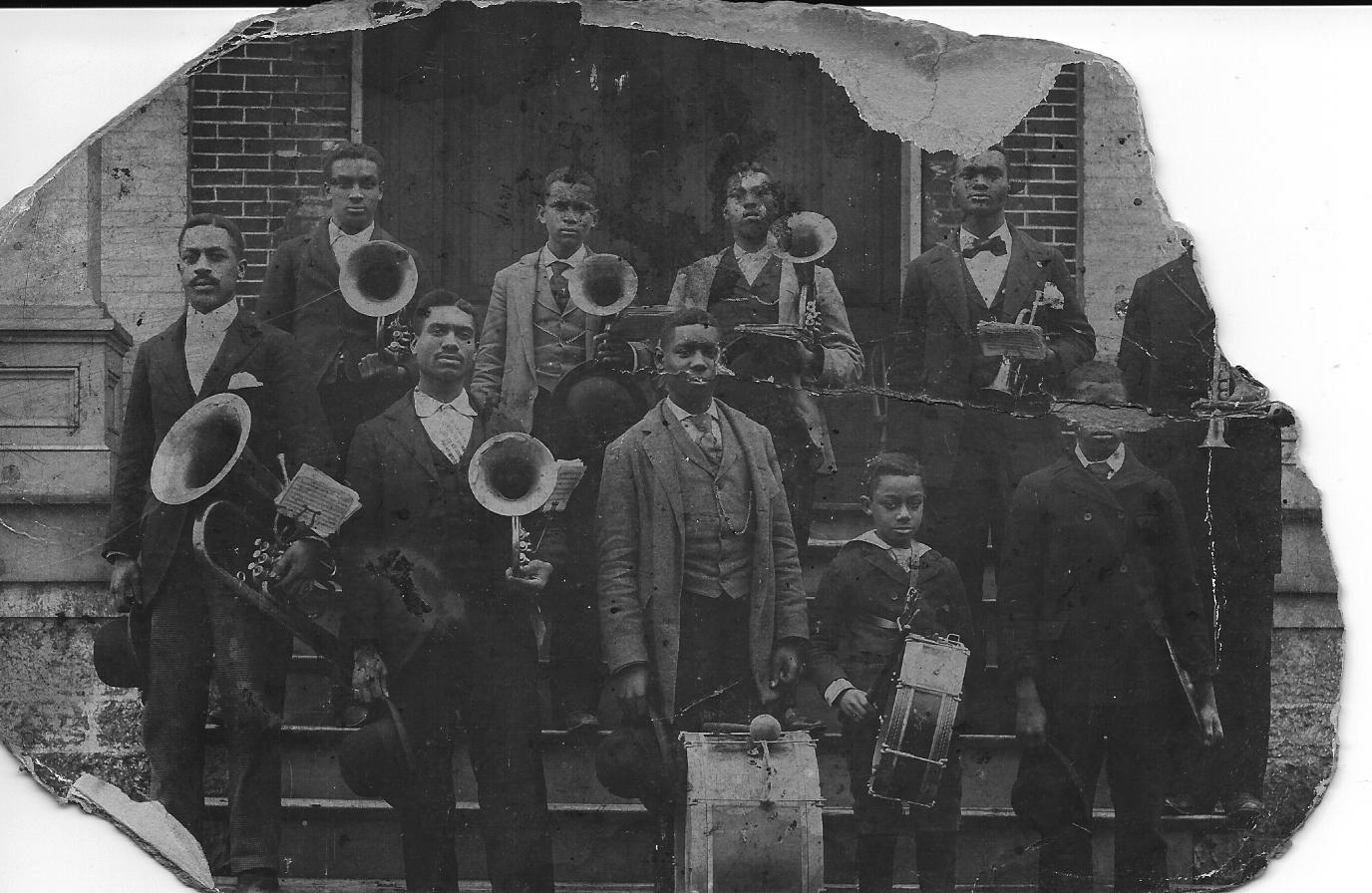
Many of the graduates who have gone out from this institution are successfully teaching in the various districts of their counties, and some are assistants in the schools of their towns. Many of these young men and women return after their schools close and take up their duties in the College Department. Classes and studies are so arranged that students may study what is most desirable, leave off at any stage, recruit their health or finances, and return to complete the course at any future time. The time to finish any course is the least possible, consistent with thorough work in all departments. The school recognizes annually the 16th of December (birthday of Honorable Eckstein Norton, after whom the school is named), Donor's Day, at which time the work is reviewed and the memory of those who have helped the institution, living or dead, is kept fresh and revered by students and friends; letters of encouragement are read and contributions announced.
The faculty is competent and consists of the following persons: Rev. C. H. Parrish, A. B., A. M., President; P. T. Frazier, A. B; Mary V. Cook, A. B., A. M.; Alice P. Kelley, A. B., A. M.; Hattie A. Gibbs, Oberlin Conservatory; Minnetta B. James, Minnesota; Cornelia Burk, Virginia; Amanda V. Nelson, Matron.
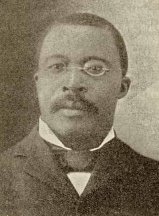 Rev. C. H. Parrish |
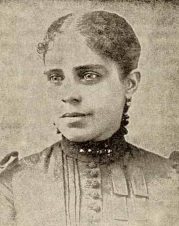 Miss Mary V. Cook |
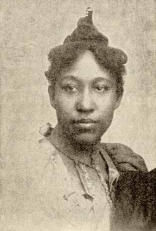 Professor Hattie A. Gibbs |
REV. CHARLES HENRY PARRISH, A. B, A. M.
One of the most remarkable men among the Negro educators of this country is Rev. C. H. Parrish. He is a native Kentuckian, and worked his way up from errand boy in a dry goods store to the presidency of a flourishing school, and one of the most noted ministers in the Baptist denomination. In infancy his mother beheld a son in whom her soul could delight. Obedient, true and faithful were traits in his character so conspicuous that he was a favorite in his town among all people.
He entered State University, Louisville, Ky., September, 1880, with Dr. William J. Simmons as president, and graduated May, 1886, at the head of his class with the degree of Bachelor of Arts. In 1886 he became pastor of the Calvary Baptist Church, where he still remains greatly beloved by a large membership, and enjoys the respect and confidence of all who know him as being an efficient minister and a Christian gentleman who loves truth for its own sake and pursues it faithfully regardless of everything.
Many honors have come to him as delegate to State, Educational and National Conventions--holding offices of trust in many. At this time he is President of the State Teachers' Association, and Chairman of the Executive Board of the General Association of Colored Baptists.
He stands at the head of the Eckstein Norton University, an institution devoted to the training of the head, heart and hand, and therefore gives to the Negro youth the kind of education best adapted to his development. He has traveled extensively in the interest of the school, and by his strict attention to business he has made the work a success.
Though Rev. Parrish leads a busy life, he finds time to look after race interests. He is author of "What We Believe," a hand-book for Baptist Churches. So highly was this work prized that the American Baptist Publication Society compiled it with works by Dr. John A. Broadus, Dr. Alvah Hovey, Dr. J. L. Burrows and others. Rev. Parrish ranks high as an educator, pulpit orator, president and author. He is clear, comprehensive and convincing in the presentation of his views upon all subjects, and adds to this fact a beauty of language, grace of rhetoric, and forceful logic, which stamps him at once as extraordinary in his gifts and acquirements.
MISS MARY V. COOK, A. B., A. M.
The subject of this sketch is a native of Bowling Green, Ky. Her life was uneventful till she reached school age, when her ability for learning asserted itself. By her persistent efforts and her insatiable desire for knowledge, she soon outgrew the educational facilities of the place, and was chafing for better advantages, when Dr. Wm. J. Simmons made it possible for her to enter the State University at Louisville, Ky.
After her graduation she was elected permanent teacher and made principal of the Normal Department, and professor of Latin and Mathematics in the State University, which position she held until a few years ago, when she was called to a like position in the Eckstein Norton University.
Miss Cook has appeared on the programmes of some of the most noted bodies of the race, read a paper on Afro-American women at the Educational Congress in Chicago, 1893, and has addressed crowded houses throughout the New England States under the auspices of the Baptist Women's Home Mission Society.
In 1892, when a fight was made against the enactment of the Separate Coach Law, she, with three other ladies, was invited to the State Capital to enter protest before the Legislature. She has traveled extensively through the South land and made a close study of her people, their progress, etc. She has gone as far west as California in the interest of the work in which she is engaged, and the school is now reaping the benefits of that trip. She has recently accepted a place on the Executive Board of the National Federation of Women, of which Mrs. Victoria Mathews is chairman.
Miss Cook is a thorough business woman; her industry and close application to affairs intrusted to her is of marked comment. She is conscientiously consistent with an honest conviction of right, to which she adheres with admirable fearlessness. She is, by her very constitution, compassionate, gentle, patient, self-denying, loving, hopeful, trustful, and by the power of her own pure soul she unconsciously molds the lives of those under her. It would be utterly impossible to live on day after day with Miss Cook, and not feel the desire for as noble a life springing up in your own heart. She has a wonderful influence over her pupils, who love her with the love that casteth out fear. And she not only influences them, but all who come in contact with her are wonderfully impressed.
Miss Cook is an intelligent little woman, a deep thinker; keeps abreast of the times and holds no mean place in the galaxy of distinguished colored women.
The women of her own State delight to honor her and have conferred upon her some of the highest offices in the organizations of which she is a member. Miss Cook has a literary inclination; being a strong, graceful writer, she has contributed much that is good to colored journalism.
When she has appeared on the public platform, she has never failed to carry her audience by the force of her terse style and convincing argument. She was recently appointed Commissioner of the State of Kentucky to the Women's Congress which convened at Atlanta, Ga., December, 1895, before which body she read an interesting paper.
Slowly and surely, step by step, Miss Cook has risen to this high plane of usefulness and her life is an inspiration, modestly displaying the great unselfish heart of the woman, whose highest ambition is to be of use to her race and humanity.
MISS HATTIE A. GIBBS.
Miss Hattie A. Gibbs is the youngest of five children of Hon. Mifflin W. Gibbs, of Little Rock, Ark., and his amiable wife, Mrs. Anna Alexander Gibbs.
Miss Gibbs entered the Oberlin Public School at six, and began the study of music at nine under the direction of her sister, who at that time had made considerable advancement in that study. At eleven she entered the Oberlin Conservatory of Music, and also kept up her studies in school for three years, after which she entered the high school and devoted all her time to those studies. After two years of hard study of Greek, Latin and Mathematics, she graduated with honors before her fifteenth birthday.
As a student she was an untiring worker, her hours for study encompassed almost the entire day. She accustomed herself to rising at four o'clock to begin her practice.
In the Conservatory Department of Oberlin College the attendance is about 500, and out of this number the average attendance of colored students is eight or ten. Students are required to finish a course of three studies before a diploma is awarded. Besides finishing the studies of piano, pipe organ and harmony, she had the advantage of several terms in voice culture, and since her graduation she has made special study of the violin in order to better prepare herself as director of Eckstein Norton Conservatory of Music, of which she was a founder and of which she is now in charge.
The women of the race should be proud of her. The people of Kentucky should be proud that one so able has placed her services within reach, and ought to show the colored peoples' appreciation, by contributing money toward erecting such suitable buildings, as will stand long after the founder is numbered with the dead--a race monument in itself.
In disposition Miss Gibbs is amiable; in mind she is great; in heart she is noble; in manners she is gentle; she has a steadfast and undeviating love of truth, fearless and straightforward in action and integrity and an honor ever unsullied by an unworthy word or deed, and after all, these traits so prominent in her make-up make her greater than her worldly success in her art, for in themselves they constitute greatness.
She has a clever handicraft at all the arts commonly styled "woman's work." Not only have her hands been trained to glide dexterously over the keyboard, but she has made every day of her life tell, and the result of her industry is that she is skilled in painting, crayon work, artistic embroidery, dressmaking, cooking and all that goes to make up an accomplished woman.
This brief sketch has been given with the hope that young people, who wish to accomplish any particular pursuit in life, may herein find an example of what a woman can do, and the truth may be brought to them that "there is no excellence without great labor."
This work has been transcribed from the original which is located on microfiche and available in the Captain John Smith Library of Christopher Newport University in Newport News, Virginia. It is also available online via Google Books where it is scanned from the copy available at Stanford University. It is in the public domain.
The following report was transcribed from The Courier Journal by Rev. J. J. Pipkin, and placed in his book, The Negro in Revelation, in History, and in Citizenship which was published in St. Louis by the N. D. Thompson Publishing Company in 1902. It appears on pages 431-2.
ECKSTEIN NORTON UNIVERSITY.
The Courier-Journal of May 18, 1902, noticed the above-named institution as follows:
"Kentucky has not been behind other Southern States in noble efforts to give colored students the benefit of a most thorough iudustrial training. One notable example of this is in the well-known Berea College, where colored and white students are equally welcome and where both sexes have equal chances.
"There is, however, an institution for the aid of colored youth by industrial training much nearer Louisville, and one which deserves the heartiest encouragement and interest of all well-wishers of the colored race. This institution is located at Cane Spring, Bullitt county, Kentucky, only twenty-nine miles from Louisville and on the line of the Louisville and Nashville railroad. It is ambitiously called the Eckstein Norton University, and its history shows that indomitable pluck and never-failing courage have been behind it thus far.
"Eleven years ago a great industrial school for the colored race was proposed by the Rev. William J. Simmons and the Rev. C. H. Parrish, who is now the president of the university. The plans were feasible and practical, but these men had no money with which to carry out their plans. They applied to Messrs. Eckstein Norton and Milton H. Smith for aid, and were cordially received by them. These gentlemen said that they had long desired to do something for the education of the colored people, and were ready to act. A few days later $3,050 was deposited in the Fidelity Trust and Safety Vault Company for the construction of a main building. This splendid gift enabled Dr. Simmons and the Rev. Mr. Parrish to open the doors of the school in October, 1890.
"The most unique railway station building between Bardstown Junction and Springfield was built at Cane Spring, the site of the university.
"In January, 1892, the main building was destroyed by fire. Appeals through the daily papers and through Mr. Smith resulted in a sum of $1,700. Another start was made, and, in the years since, upwards of 1200 students from sixteen States and foreign countries have received instruction. One hundred and thirty-one have graduated from the different departments, the majority of whom are doing creditable work among the people.
"The main building is a substantial brick structure with twenty-five rooms. There are also five frame buildings with twenty rooms for dormitories and assembly halls, the printing office, laundry and blacksmith shop. The accommodations are not adequate to the demands upon them.
"The principle of the school is that all must work. Students must do as well as know. It is designed to give here a Christian education, a trade and college advantages to those who show any special fitness for the highest training. Classes are conducted in laundry work, cooking, sewing, shoemaking, farming, carpentering, waiting on table, printing and blacksmithing.
"The school is undenominational, and is, of course, without denominational aid. Nor does it have State or general government assistance, but is simply a brave effort dependent entirely upon voluntary aid. Here is, indeed, an endeavor to better the condition of the Negro race along lines which, in the case of Tuskegee and other similar institutions, are receiving substantial support and much praise from Northern philanthropists."
Additional newspaper articles about this school are located on another page.
If you, the reader, have an interest in any particular part of our county history, and wish to contribute to this effort, use the form on our Contact Us page to send us your comments about this, or any Bullitt County History page. We welcome your comments and suggestions. If you feel that we have misspoken at any point, please feel free to point this out to us.
The Bullitt County History Museum, a service of the Bullitt County Genealogical Society, is located in the county courthouse at 300 South Buckman Street (Highway 61) in Shepherdsville, Kentucky. The museum, along with its research room, is open 10 a.m. to 4 p.m. Monday through Friday. Saturday appointments are available by calling 502-921-0161 during our regular weekday hours. Admission is free. The museum, as part of the Bullitt County Genealogical Society, is a 501(c)3 tax exempt organization and is classified as a 509(a)2 public charity. Contributions and bequests are deductible under section 2055, 2106, or 2522 of the Internal Revenue Code. Page last modified: 12 Sep 2024 . Page URL: bullittcountyhistory.org/bchistory/ecknorton.html